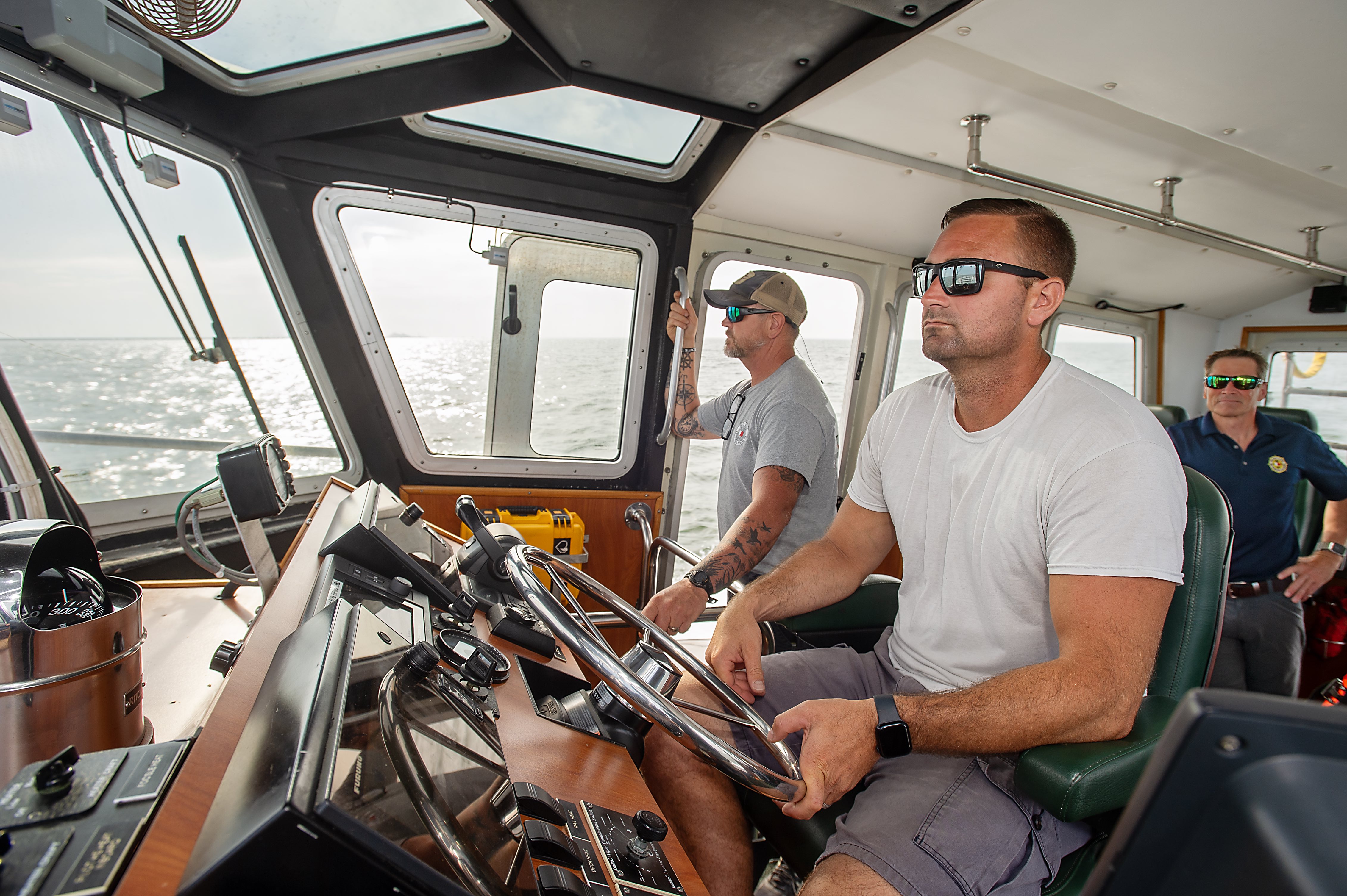
Lewes’s bay-and-river pilots continue a 400-year tradition
By Bill Newcott
Photograph by Scott Nathan
From the September 2023 issue

The Ineos Independence is a mile or so ahead of us, headed toward open sea just off Cape Henlopen. Here on the river pilot vessel Brandywine, skipper Jesse Billings is playing catch-up, chasing the blue-and-white merchant ship which, while it has slowed down considerably for the meet-up to come, is nevertheless plowing ahead on its way to the Atlantic.
At less than 600 feet long, the Independence is far from the largest ship to ply these waters. Still, the two enormous white tanks on its deck create an imposing presence. Yesterday it was docked in Marcus Hook, south of Philadelphia, filling those tanks with liquefied natural gas. Like a gridiron waterboy, the Independence spends much of its time these days shuttling between Marcus Hook and Rafnes, Norway, a nine-day trip, alternately filling up with and emptying itself of LNG.
There is one bit of cargo, though, that the Independence must surrender before hitting the high seas: Kelly McCandless, the Lewes-based river pilot who, for the past eight hours or so, has been on board, guiding the ship through the sometimes tricky channels of the Delaware River and beyond.
The waters of Delaware Bay are pretty calm this morning. There’s not a lot of pitching going on as the twin-screw, 53-foot-long Brandywine pulls up to the side of the larger ship. But the Independence is on the move, and so is the chase vessel. This maneuver is not for amateurs.
McCandless is gingerly walking on a gangway ramp that reaches about three-quarters of the way down the Independence’s starboard hull. At the end of that, flat against the ship, is a rope ladder with wooden rungs. She’ll be transferring from the ramp to the ladder, then climbing down to the bobbing deck of the Brandywine.
For McCandless and Billings, the coming transfer is as routine as a kiss-and-ride drop-off. For me, it’s as daring as a scene from a James Bond movie.
Less than a half-hour ago, I was sitting in the Pilots’ Association for the Bay and River Delaware station, just north of the Cape May-Lewes Ferry terminal. The stately 85-year-old building, three wood-shingled stories with a widow’s walk perched up top, has the cozy feel of a Schuylkill River boathouse; there are polished bannisters, cabinets busy with sea-centric memorabilia, and photographs of river pilots dating back more than a century.
It’s clear not much has changed in here over the years, and that the incursion of modernity has at times been more tolerated than welcomed. Tucked into one corner is a bank of computer monitors, where longtime pilot Dan MacElrevey is watching the progress of various ships in the bay and beyond.
As I look over his shoulder, MacElrevey has some not-so-great news.
“One of our ships isn’t coming,” he reports. A cargo vessel that was scheduled to take on a pilot at Lewes before heading upstream has been turned away, probably because its destination berth is not yet available.
“Welcome to the maritime business,” he smiles.
There is, however, another ship heading down the bay, arriving in just a few minutes, with a pilot who needs to be offloaded. The ship is the Independence and the pilot is McCandless. We’ll be heading out to fetch her in a few minutes.
This is the rhythm of the river pilot’s life: Like the tide itself, the pilot flows upriver, stays for a time, then courses back to the sea. There are 70 full-time pilots in the association — mostly men, but an increasing roster of women. The number of assignments a pilot takes each year depends completely on the amount of traffic.
Last year, MacElrevey estimates, he guided just over 100 ships up or down river. That may seem like a lot of ships, but for MacElrevey, who began his three-year internship with the association in 1995 and then stayed on, each one is just another day at the office. The pilots work in rotations of three to four days, during which they can stay home until a phone call summons them to the station. Pilots who live nearby just need a half-hour or so heads-up; one pilot lives all the way across the Delmarva peninsula in St. Michaels, so he needs two hours’ notice.
MacElrevey lives just a mile or so from the station, in Lewes, with his wife. But his journey here was a circuitous one: Born in Cape May, N.J., he grew up in the Panama Canal Zone, where his father had the unimaginably specialized job of piloting ships between the Atlantic and Pacific oceans. Returning to the states, he applied to pilot associations around the country, and was happy to settle in just a ferry ride away from his birthplace.
As a second-generation pilot, MacElrevey would not complain if his two children wanted to follow in his footsteps.
However, “my daughter’s not interested,” he says. Then he adds hopefully, “But my son is.”
I’m standing in the stairwell at the Lewes river pilot station, looking into the faces of generations of local pilots, and I can’t help but notice a lot of the names seem to repeat themselves. Indeed, it’s not unusual to find third-generation pilots in the association’s chronology. (Official positions here just go back to 1896, when the organization was founded. Before that, pilots had a loose and often antagonistic fellowship — when a merchant ship turned up, the men would jump into their boats and raise the sails: First one there got the job.)
Dick Buckaloo’s first real job was as an apprentice river pilot in Lewes. Go ahead, ask him how long he’s been at it.
“I started on July 1, 1964, 19 years old,” he tells me, leaning across the long mahogany table in the station’s cozy meeting room. After four years of apprenticeship, he became a full-fledged pilot.
About that time, Dick’s son Bill was born. He’s also sitting across the table from me. He’s been a river pilot since 1997.
But while it may be tempting to say the piloting business is stubbornly nepotistic, it seems to have more to do with being conditioned to the career from childhood. Sure, mom or dad may spend three or four days a week away on the river — but then they’re home an equal amount of time between shifts, sharing stories about the mariners they’ve met, the far-flung places those people hail from … and especially the food they share.
“I think the best part of the job was the food,” says Dick Buckaloo, who retired at the mandatory age of 70. “When I first started, there were a lot of Italian ships, and they had the best Italian food. And there was terrific Greek food on the Greek ships, and really good food from Eastern Europe — Russian, Bulgarian, Romanian.”
These days, world economics leads most shipping companies to register their ships in remote, tax-friendly places like Liberia, the Bahamas and Panama (the Independence, operated by a Norwegian company, flies the flag of Malta). Their crews tend to be from Asia and the Philippines, and while the junior Buckaloo also misses the Italian food, he notes that “the Filipinos are the best seamen in the world. They know what they’re doing, and they know you know what you’re doing.”
There are few professions that predate river piloting in coastal Delaware. It’s likely that the Italian explorer Giovanni Verrazzano employed a member of the local indigenous people to help him navigate the waters of lower Delaware Bay in the 1520s. Indigenous pilots continued to play a major role in navigation for centuries thereafter, but, no surprise, the Europeans periodically asserted themselves in the field. In 1655, during the waning days of the ill-fated Cape Henlopen colony of New Netherlands, the governor hired a pair of Dutchmen, Sol Garretson and Peter Lourison, to guide ships using their “perfect knowledge of the bottom, depths and shoals” of the Delaware River and bay, according to one historical source.
Philadelphia and Lewes are hardly sister cities, but they have always been joined at the hip when it comes to river commerce. From the 1700s onward, virtually every Philadelphia-bound merchant ship was boarded by a Lewes pilot. After a railroad line was extended to Lewes in 1859, the standard practice was for Lewes pilots to guide ships upstream and Philadelphia pilots to usher them back to sea — with the pilots of each town traveling home by rail. (These days, Lewes-based pilots either ride upriver on one ship and back down on another, or drive home from Philly in an association vehicle.)
Still, through most of the 19th century, piloting was largely a hodgepodge of local freelancers jockeying for position, each one keeping an eye on the peak of the Cape Henlopen Lighthouse, where the keeper announced approaching ships by raising a large black ball. On that signal, hopefuls would board private schooners that rushed them to the arriving vessel — for a $2 fee. For the pilots, it was a worthy investment: A successful Delaware River pilot, making successive three-week trips to Philadelphia and back, could take home $600 a year (a tidy sum in those days).
Take a stroll along Second Street about a block from the busy commercial area and you’ll spot an impressive green Victorian house with striped awnings and four gabled windows on the top floor. The sign outside will tell you all you need to know: The place was built by John Penrose Virden, son of a sea captain and co-founder and first president of the Pilots’ Association for the Bay and River Delaware.
From the start, the organization worked to streamline and modernize the piloting profession. An apprenticeship program was established. Lists of available pilots were assembled to replace the old “me first” system, and a new steam-powered ship, the Philadelphia, was built to shuttle pilots to their assignments.
Most significantly, the piloting fees charged to each incoming ship were pooled, and after-expenses income was distributed among the pilots. That business model persists to this day: Ships are charged a fee based on their size (the minimum is $1,800), and the pilots receive regular paychecks.
The Brandywine is coming alongside the Ineos Independence. Were this an incoming ship, we’d be delivering a pilot armed with a laptop computer bearing the latest channel soundings from the National Oceanic and Atmospheric Administration along with satellite telemetry.
Some ships have a combination gangway/ladder affair like the one that dangles from the Independence’s side. Others have a large portal, just above the waterline, that allows a pilot to simply step from one vessel to the other. Still others offer pilots nothing more than a simple ladder, reaching from deck to deck.
However pilots get on board, they are met by a crew member who immediately escorts them to the bridge, where they shake hands with the captain, who then turns complete control of the ship over to the local expert.
“That handshake is one of the great traditions of being a river pilot,” says Bill Buckaloo. “It goes back hundreds of years. I missed it a lot during COVID, when I’d have to stay on one side of the bridge and the captain would stay on the other.
“Of course, it was really to protect them from me. They had their own social bubble. When I was on a ship, I felt it was a lot safer than being at Walmart.”
After that ceremonial greeting, the captain and the pilot engage in what’s called a master/pilot exchange, as the skipper runs down operational details, from the presence of a bow thruster to steering pumps that might not be working correctly.
“Then,” says Bill Buckaloo, “I’ll say, ‘OK, Captain, I’ve got you.’ Or ‘I’ll take it from here.’”
From that moment, the pilot steers the ship, which apparently used to be a lot more fun than it is now, to hear the veteran Dick Buckaloo tell it.
“In the old days,” he says, “they had these great big ship’s wheels, like you see in the movies.” He extends his hands, as if he’s got them positioned at 10 and 2 o’clock on the Jolly Roger.
“Now, they maneuver these enormous ships with what looks like a joy stick for a video game.” He shakes his head ruefully.
Technically, the pilot never takes actual command of the ship; he or she can always be overruled by a captain who thinks he (or she) knows better. But in practice, they all know better than to think they know better.
“The only place in the world where the pilot can [officially] overrule the captain is in the Panama Canal,” says Bill Buckaloo.
It costs a small fortune in fuel, not to mention precious time, to stop and reaccelerate a 600-foot merch-ant ship. So the Independence and the Brandywine are engaged in a bobbing ballet, keeping pace with each other as the disembarking pilot gingerly negotiates the gap between the gangway and the rope ladder, then climbs down the last eight rungs to the Brandywine’s deck.
Kelly McCandless, wearing an orange life jacket and white safety helmet, takes a few steps along the Brandywine’s outside deck, then stops to look upward and shout a goodbye. Moments later she’s sitting inside the cabin. Billings is already gunning the engines to take us back home.
McCandless, who grew up in Bethany Beach, is the first pilot in her family. She attended the State University of New York Maritime College and began her apprenticeship in 2008, and has been piloting for more than a decade.
“It’s great that I get to work so close to home,” she says as we bounce across the bay waters. “I’ve got two little kids, so that’s important.”
How cool do they think it is to have a mom who climbs rope ladders on the open sea?
She laughs.
“As cool as any 7- and 3-year-old can imagine anything is,” she says. “We have the occasional nor’easter, and that can get pretty exciting, but it’s not the kind of thing I’ll tell them about. I wouldn’t want them to worry.”
I can’t help but notice McCandless carries a smile that will not quit. Does she enjoy her job that much?
“What’s not to love?” she asks me. “I’m not stuck in an office; I’m outside every day.
“And on top of all that: I get to make these enormous ships do everything I want them to do. It’s just the best.”
We’re getting close to shore. By the time we tie up at the pilot station, we’ve been out barely 35 minutes.
As we climb the short ladder to the dock, someone yells to McCandless: “Better get home and make dinner for your husband.”
She laughs again.
“I think I’ll find a happy hour first.”



